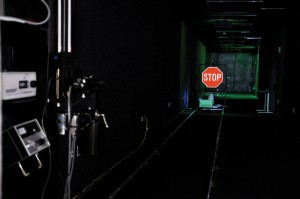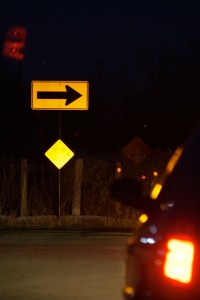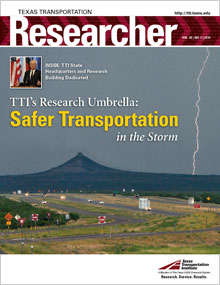
“A dark and stormy night” is more than a clichéd way to introduce a story — it’s a dangerous driving scenario when the visibility of road signs becomes critical for safe passage.
Nighttime traffic fatality rates are three times higher than their daytime equivalents. While fatigue and alcohol play important roles in nighttime crashes, Texas Transportation Institute (TTI) researchers Paul Carlson and Jeff Miles focus on optimizing visibility to help reduce crashes at night.
For over a decade, TTI has developed innovative ways to improve visibility in nighttime driving and played a major role in standardizing visibility test methods. That dedication to finding solutions has paid off with the grand opening of TTI‘s Visibility Research Laboratory, located on the first floor of TTI‘s new State Headquarters and Research Building.
“TTI has a long history of nighttime visibility research with field equipment and human factors studies, but this lab provides a whole new way to conduct and develop standardized testing,” says Carlson, head of TTI‘s Operations and Design Division. “We now have better control of the variables so we can develop new test methods and standards.”
The lab is the first of its kind in a university setting. Previously, researchers stayed up most of the night to conduct visibility studies at the Texas A&M University Riverside Campus while relying on Texas weather to cooperate. Now, with the 125-foot tunnel-shaped facility, those same researchers can run night simulations under controlled conditions at any time during the day. An adjacent conference room provides space for presentations, where sponsors and visitors can examine samples of reflective materials with microscopes.
The lab features a custom goniometer — an instrument with a light source on one end and a frame that adjusts along three different axes on the other. The frame supports the material being tested, such as a stop sign. When the angle changes, a computer records the changing optical data as the light retroreflects off the sign. Researchers can test the retroreflectivity of materials for traffic signs and pavement markings, as well as measure the visibility properties of all types of vehicle headlamps, sign lighting and roadway lighting.
“The benefit of this system and this lab is being able to test 1,001 different samples in a short amount of time to narrow down to a few that we’ll then take out into the field,” says Miles, an assistant research engineer for the Signs and Markings Program. “The goniometer makes testing different geometries quick, accurate and effective.”
One current project uses pavement stripes to test retroreflective optics for night driving to develop new testing methods for state department of transportations that will lead to more consistent quality on the road. In conjunction with new nationwide standards of minimum retroreflectivity maintenance levels for traffic signs, researchers are also using the lab to produce step-by-step guidelines to construct calibration signs near the minimum maintenance levels for nighttime inspections, which will help transportation agencies cost-effectively stay in compliance with the new national standards. Another project starting soon will test how light-emitting diode (LED) technologies could be used in traffic signs in the United States. LED lights are prominently used in signs in other countries, but more research on how to best incorporate LED lighting into traffic signs is needed before they can be adopted by the United States.
 “This lab expands our technical capabilities and has the potential to bring in new research partners, including the development of specifications and test methods for other countries and designing and testing experimental materials with private industry,” says Carlson. “It will open the door to expand and diversify our research.”
“This lab expands our technical capabilities and has the potential to bring in new research partners, including the development of specifications and test methods for other countries and designing and testing experimental materials with private industry,” says Carlson. “It will open the door to expand and diversify our research.”
The research possibilities are numerous since other TTI divisions and Texas A&M University departments can also access the lab. Talks are underway about a possible master’s-level class for the Civil Engineering Department. Human factors studies are being planned for the summer. Also in the future, field instruments could be calibrated in the controlled conditions. The lab currently has the ability to be used for evaluating existing rain measurement test methods but could be modified to study the impacts of fog and rain under a large range of nighttime conditions.
“When drivers travel at night, they rely heavily on the visibility of traffic control devices to reach their destination safely. TTI‘s new Visibility Research Lab is a first-class facility that can be used to help answer technical questions related to the nighttime visibility needs of drivers,” says Greg Schertz, retroreflectivity team leader for the Federal Highway Administration. “Ultimately, we hope that leads to solutions for the huge disparity in the severe crash rates of nighttime versus daytime.”
Retroreflection 101
- “Retroreflectivity” describes how a surface reflects light directed back toward the source.
- “Luminance” means the brightness of a sign. Too much luminance produces the “blooming effect” — when the contrast between the darkness around the sign and light retroreflecting from a sign blurs the letters together, making it hard to read.
- Pavement paints (the stripes on the road) contain micro-sized glass spheres that help drivers see where they are going. The glass beads — so small that a jar full of them looks like powder — retroreflect the light from headlamps to the driver’s eyes. But when the glass beads get wet, their ability to retroreflect light is severely diminished, if not completely lost.
- Retroreflective raised pavement markers (RRPMs) — the roadway bumps some drivers make sport of avoiding when changing lanes — supplement pavement paints specifically for wet driving conditions. The life span of an RRPM is less than 18 months.
